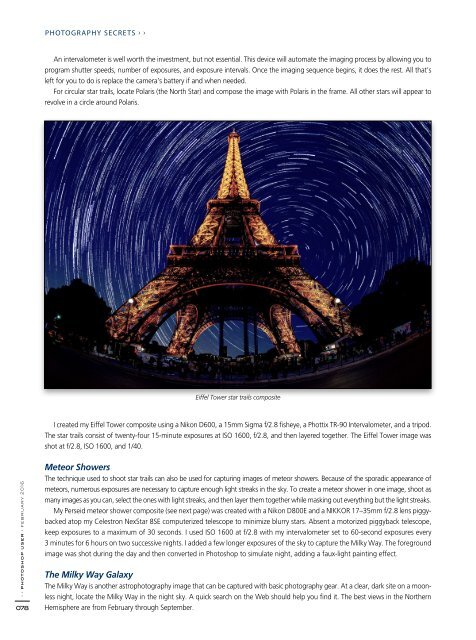Create successful ePaper yourself
Turn your PDF publications into a flip-book with our unique Google optimized e-Paper software.
PHOTOGRAPHY SECRETS › ›<br />
An intervalometer is well worth the investment, but not essential. This device will automate the imaging process by allowing you to<br />
program shutter speeds, number of exposures, and exposure intervals. Once the imaging sequence begins, it does the rest. All that’s<br />
left for you to do is replace the camera’s battery if and when needed.<br />
For circular star trails, locate Polaris (the North Star) and compose the image with Polaris in the frame. All other stars will appear to<br />
revolve in a circle around Polaris.<br />
Eiffel Tower star trails composite<br />
I created my Eiffel Tower composite using a Nikon D600, a 15mm Sigma f/2.8 fisheye, a Phottix TR-90 Intervalometer, and a tripod.<br />
The star trails consist of twenty-four 15-minute exposures at ISO 1600, f/2.8, and then layered together. The Eiffel Tower image was<br />
shot at f/2.8, ISO 1600, and 1/40.<br />
› › photoshop user › february <strong>2016</strong><br />
078<br />
Meteor Showers<br />
The technique used to shoot star trails can also be used for capturing images of meteor showers. Because of the sporadic appearance of<br />
meteors, numerous exposures are necessary to capture enough light streaks in the sky. To create a meteor shower in one image, shoot as<br />
many images as you can, select the ones with light streaks, and then layer them together while masking out everything but the light streaks.<br />
My Perseid meteor shower composite (see next page) was created with a Nikon D800E and a NIKKOR 17–35mm f/2.8 lens piggybacked<br />
atop my Celestron NexStar 8SE computerized telescope to minimize blurry stars. Absent a motorized piggyback telescope,<br />
keep exposures to a maximum of 30 seconds. I used ISO 1600 at f/2.8 with my intervalometer set to 60-second exposures every<br />
3 minutes for 6 hours on two successive nights. I added a few longer exposures of the sky to capture the Milky Way. The foreground<br />
image was shot during the day and then converted in Photoshop to simulate night, adding a faux-light painting effect.<br />
The Milky Way Galaxy<br />
The Milky Way is another astrophotography image that can be captured with basic photography gear. At a clear, dark site on a moonless<br />
night, locate the Milky Way in the night sky. A quick search on the Web should help you find it. The best views in the Northern<br />
Hemisphere are from <strong>February</strong> through September.


